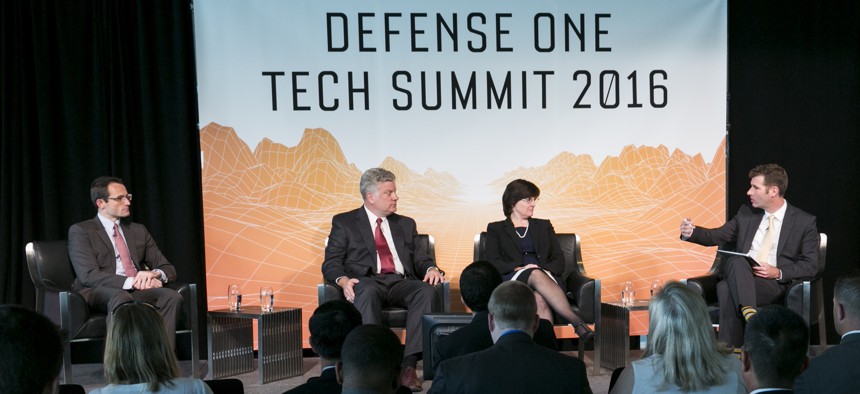
Will Roper, director of the Strategic Capabilities Office, left, at the Defense One Tech Summit, in Washington, D.C., June 10, 2016. Kristoffer Tripplaar
The Pentagon’s Secret Weapons Guru Asked For Your Crazy Ideas & Got 1,000 in 1 Month
Will Roper, director of the Defense Department's Strategic Capabilities Office, got "exactly what we want" from the public.
An open call for “novel concepts” by the Pentagon’s secret-weapons guru William Roper has produced almost a thousand responses in less than one month, some of them surprisingly promising.
Roper heads the Strategic Capabilities Office, or SCO, which is at the head of Defense Secretary Ash Carter’s efforts to make the military more innovative and agile. Roper’s outfit published a request for research proposals last month, -- called a Broad Area Announcement, or BAA, -- which asks for “novel concepts in the following focus areas: Autonomy, Command and Control, Cyber, Sensors, and Weapon Technologies,” and is what Roper calls “an open door for the outside world to bring us ideas.”
“I was afraid when we put the BAA out that I would get the old ideas that I’ve seen many times, that now have a new label, a new name, a new graphic, but it’s the same idea,” Roper said. “And there’s a little bit of that. But I have seen people put in some things that are different. There are companies that haven’t really done a lot of work with the government. All of that is exactly what we want. We want people who have creative ideas to be able to get to us.”
The SCO trades in this world of ideas, helping the U.S. military keep its tech advantage in the crazy-quilt of modern warfare by finding creative ways to repurpose existing technologies or integrate them with new ones. Roper’s go-to example is the SM-6 missile , which the SCO helped repurpose to strike enemy ships.
He’s just recently started talking about the electromagnetic railgun, which captures imaginations and creates “a different paradigm of missile defense,” but has also led the military to realize “we were not pulling all of the tricks that we could pull in powder guns,” he said.
Related: Can the Navy’s Electric Cannon Be Saved?
“We now think that we can do pretty revolutionary things with existing powder guns — think the Howizers, the Navy’s 5-inch guns. So we’ve shifted emphasis to that, not because we’re not interested in railguns, because we are, but when you look at the delta between fueling and quantity, you’ve got over 1,000 powder guns, but just a few railguns.”
Of course, Roper doesn’t discuss the specifics of most of the rest of his office’s projects, and declined to reveal the “creative ideas” generated by the BAA. For the new pitches, that’s in part due to the legality of government contracting — “obviously for any kind of competitive decision I can’t discuss the specific [ones] that jump ahead of the others,” he said.
More importantly, though, is the need to keep the majority of the unconventional applications and new technologies confidential. Deciding which surprises to reveal or conceal — enough of the former to deter wars, but enough of the latter to win them — is akin to “multivariate calculus,” Roper says.
So don’t expect big reveals on the BAA submissions any time in the near future, particularly since the call is staying “open as a revolving door around the year.” The SCO has to “generate new ideas in every budget in order to stay around,” Roper said, noting that $840 million of the office’s $900-million budget was awarded to individually pitched projects.
“If you have an idea,” Roper said with a smile, “go to FedBizOps and search for ‘SCO.’”
[Editor’s note: here’s the BAA.]




